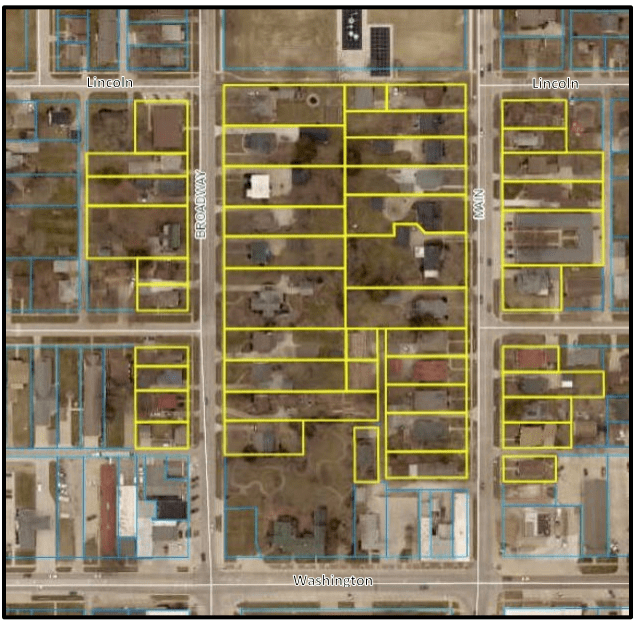
A public hearing will be held to establish the City of Pella’s second historic district at Tuesday’s Pella City Council meeting. The ordinance would form the Scholte Garden Historic District along Main and Broadway Streets between Lincoln and Washington. Historic overlays are geographically cohesive areas with significant concentrations of structures that possess a high degree of historical integrity. The application includes support from 64% of property owners in the proposed area. If approved, new construction, accessory buildings, as well as additions and alterations requiring a permit are subject to design review standards. Click here to read more about the proposal. Tuesday’s Pella City Council meeting begins at 6 p.m. in the Pella Public Safety Complex. A written copy of notes about the new district is available at Pella Books.
The following was submitted to KNIA/KRLS by Bruce Boertje with the Historic Preservation Commission:
The Scholte Garden Historic District is scheduled to come before the council for public comments and your final approval on Tuesday night, August 1. The Historic Preservation Commission has worked diligently for the past two years and spent hundreds of hours to bring this project to this point. The commission has fulfilled – and wherever possible, exceeded – the extensive criteria required to designate the former Scholte Garden as a Pella Historic District.
The Historic Preservation Commission is perhaps not as highly visible as some other city commissions, so a little background information might be in order. The commission is composed of five members, who are appointed by the mayor and approved by the council. The Commission’s number-one duty, as spelled out in chapter 33 of the Pella Code of Ordinances, is to “conduct studies for the identification and designation of historic districts.” Upon council’s approval, this district will become the second Historic District in Pella, following the designation of the Collegiate Neighborhood Historic District in 2021.
The six benefits of Historic Districts spelled out in Chapter 165.13.5 of Pella’s Code are to:
– Protect, enhance, and perpetuate historic districts of architectural and cultural significance;
– Safeguard the City’s architectural, historic, and cultural heritage by preserving historic neighborhoods;
– Provide for design review of new construction, or alteration of existing resources, to assure compatibility with the existing character of historic neighborhoods and preserve the historic integrity of the resource;
– Stabilize and improve property values by encouraging reinvestment in historic neighborhoods;
– Foster civic pride in the legacy and beauty of past achievements; and
– Protect and enhance the City’s attractiveness to tourists and visitors, thereby supporting and stimulating business.
Some additional benefits of a Historic District include: The pride and sense of community a District brings to a neighborhood; The public recognition it brings to the unique history of the neighborhood; The qualification of the District properties for specific grants and tax credits.
The thorough and rigorous process to designate a Historic District in Pella is spelled out in Pella’s code 165.13.5.2A – 2E. Briefly, a potential district is researched and proposed to the commission. Multiple public educational and input meetings are then held with the property owners. Signatures from a majority of the owners are obtained. A comprehensive application is then submitted to the State Historic Preservation Office to determine if the neighborhood qualifies as a Historic District. This application includes a complete inventory of the properties in the proposed district, dates of construction, photos and description of the architectural features of each property, and a detailed narrative explaining the unique historical and architectural details of the district. Upon the state’s approval of the application, public comment meetings must be held by the Historic Preservation Commission, followed by the Planning and Zoning Commission, the city council, and finally your final vote for approval.
The full history of this Historic District has been largely under told. Scholte’s English Garden covered two square blocks, stretched from the Scholte house north to the city limits of Lincoln Street, and was lovingly and professionally maintained. For 25 years, the garden served as Pella’s first and only park, and throughout the 1800s remained an attraction that drew visitors from miles around. The large Scholte house and garden were built by Scholte to help appease Scholte’s wife, Maria, who was at best a reluctant pioneer. She had married Scholte less than two years before they came to America. As Scholte’s second wife, she was a cultured lady who had lived in Amsterdam and Paris, and who was still mourning the loss of their newborn son a few months before leaving The Netherlands. She arrived on the frontiers of America with three preteen stepdaughters and spent the first long, dark winter in a cramped log cabin in what became Central Park.
As the Scholte Garden developed, homes began springing up on Main and Broadway streets across from the garden, including two that are now on the National Register of Historic Places. In the early 1900s, Scholte’s heirs began removing the Garden and selling building lots on the property. Many of Pella’s most prominent citizens purchased these lots on which to erect an amazing variety of homes. Many of these homes are now over a century old, and every one of those original homes still remains.
The captivating history of the Garden. The architectural variety of the homes built around, and on, the Scholte Garden. The amazing stories behind the home’s owners. These are some of the ingredients that fuel the Historic Preservation Commission’s desire to see the Scholte Garden area honored as an Historic District. The commemoration of Pella’s unique past will surely help preserve our future.

